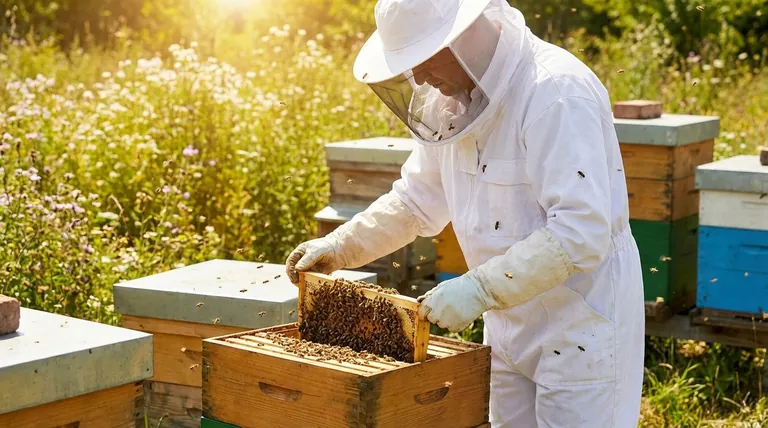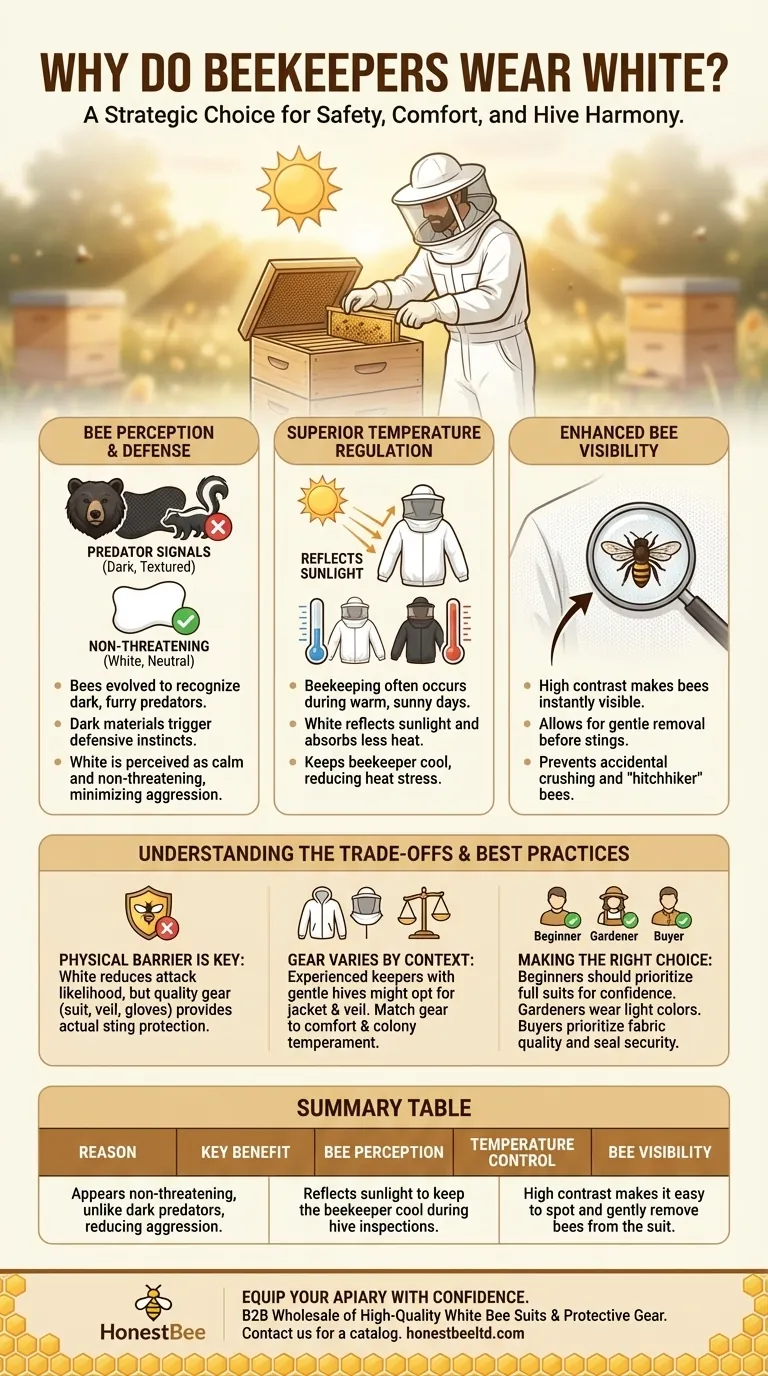At its core, the choice of white for beekeeping suits is a strategic decision rooted in bee biology and human safety. Beekeepers wear white primarily because it is a calm, non-threatening color to bees, it reflects sunlight to keep the beekeeper cool, and it makes it easy to spot bees on the suit's surface.
The decision to wear white is a simple yet powerful way for a beekeeper to manage risk. It directly addresses the bees’ defensive instincts and the practical physical challenges of working with hives, creating a safer environment for both the bee and the keeper.

Understanding Bee Perception and Defense
The color of a beekeeper's suit is the first step in communicating a lack of threat to the hive. It leverages the bees' natural instincts to prevent an aggressive response before it begins.
Mimicking Nature's "Safe" Signals
Bees have evolved over millions of years to recognize and defend their colonies against natural predators. Many of these predators, like bears, skunks, and badgers, are dark and furry.
Consequently, bees can interpret dark, textured materials as a potential threat, triggering a more aggressive and defensive reaction. White is a neutral color in their world, associated with nothing that would naturally prey on them.
Promoting a Calm Hive Environment
By wearing white, a beekeeper minimizes the chances of agitating the colony's guard bees. A calm hive is not only safer to work with but also more productive, as fewer bees are diverted from their tasks to mount a defense.
The Practical Advantages for the Beekeeper
Beyond bee psychology, the choice of white offers significant functional benefits that make the difficult job of beekeeping more comfortable and secure.
Superior Temperature Regulation
Beekeeping is often performed during warm, sunny days when bees are most active. A white suit reflects a significant amount of sunlight and absorbs less heat, keeping the beekeeper cooler and reducing the risk of heat stress or exhaustion.
Enhanced Bee Visibility
It is crucial for a beekeeper to see any bees that land on their suit. The high contrast of a dark bee against a white background makes them instantly visible.
This allows the keeper to gently brush them off before they can sting or be accidentally crushed. It also prevents "hitchhiker" bees from being carried away from the apiary, which can disorient them and cause distress.
Understanding the Trade-offs
While color is an important factor, it is only one component of a complete protective system. Relying solely on a white suit without understanding its context can lead to a false sense of security.
Color is Not a Substitute for Proper Gear
The primary function of beekeeping attire is to provide a physical barrier against stings. The suit, veil, and gloves are the essential tools.
The color white is an optimization that reduces the likelihood of an attack, but the integrity of the suit itself is what provides the actual protection.
Gear Varies by Experience and Temperament
Not all situations require a full suit. Experienced beekeepers working with a particularly gentle hive may opt for just a jacket and veil. The choice of gear depends on the beekeeper's comfort level and the specific temperament of the colony they are managing.
Making the Right Choice for Your Goal
Understanding these principles allows you to make safer choices, whether you're a professional beekeeper or a casual gardener.
- If your primary focus is beginning beekeeping: Always choose a full, white bee suit to maximize protection, build confidence, and minimize hive agitation while you learn.
- If your primary focus is gardening or working near bees: Wear light-colored clothing to reduce the chance of being perceived as a threat and provoking a defensive sting.
- If your primary focus is purchasing beekeeping equipment: Prioritize the quality of the fabric and the security of the seals on a suit, recognizing that while white is the standard, the physical barrier is what ultimately keeps you safe.
Working in harmony with the bees' natural instincts is the foundation of effective and safe beekeeping.
Summary Table:
| Reason for Wearing White | Key Benefit |
|---|---|
| Bee Perception | Appears non-threatening, unlike dark predators, reducing aggression. |
| Temperature Control | Reflects sunlight to keep the beekeeper cool during hive inspections. |
| Bee Visibility | High contrast makes it easy to spot and gently remove bees from the suit. |
Equip your apiary with confidence. At HONESTBEE, we supply commercial apiaries and beekeeping equipment distributors with high-quality, durable white bee suits and protective gear designed for maximum safety and comfort. Our wholesale-focused operations ensure you get the reliable equipment you need to work in harmony with your bees. Contact our team today to discuss your needs and request a wholesale catalog.
Visual Guide

Related Products
- Cotton Beekeeping Suit and Round Hat with Veil Bee Keeper Protective Gear
- White Beekeeping Protective Suit and Hat with Fencing Veil for Beekeepers
- Heavy Duty Cowboy Beekeeper Hat with Visibility Veil Outdoor Professional Beekeeping Protective Gear
- Professional Beekeeping Suit for Kids and Girls Childrens Bee Keeper Suit
- Beekeeper Cowboy Hat and Veil for Beekeeping
People Also Ask
- What factors should be considered when choosing a beekeeping suit? Balance Safety, Comfort & Performance
- Why is white the predominant color in bee suit designs? | Key to Hive Calm & Beekeeper Safety
- Why is a jacket with a hat veil recommended for beekeepers? Essential Protection for Your Face and Neck
- What is recommended for beginners in beekeeping regarding protective clothing? A Complete Safety Guide for New Beekeepers
- What should be considered regarding the color of beekeeping clothing? Ensure Your Safety and Keep Bees Calm



















